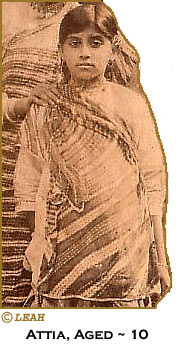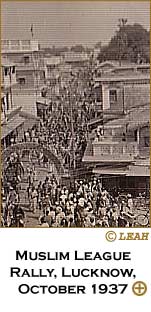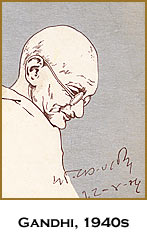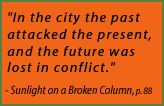3. The Early Muslim League QUESTION: When did you start hearing about Pakistan and the Muslim League?  ATTIA HOSAIN (AH): You must know all about the early years of the development of the Muslim League and the Aga Khan. This kind of feeling [of a separate state for Muslims], I was never conscious of it as being so all pervading as it became, because up to this time [the 1920s and 1930s], it was always a question of the British and how we are going to be free [of them].
ATTIA HOSAIN (AH): You must know all about the early years of the development of the Muslim League and the Aga Khan. This kind of feeling [of a separate state for Muslims], I was never conscious of it as being so all pervading as it became, because up to this time [the 1920s and 1930s], it was always a question of the British and how we are going to be free [of them]. That was much more important. And one thought, growing up that all those who might talk like the Aga Khan, who was trying to revive the Muslim League, or anybody, it is a certain class of people now trying to do this because they are pro-British. I, from my later teens, or fourteen years old, began to be much more drawn towards the Congress [which stood for an undivided India].  So from now on if you get any kind of slant, it will always be that I was influenced very much by left wing thought and by Panditji's and Gandhiji's movementsbecause I would stand and watch as the processions went by and hear the sound of "Inqillab - Zindabad" [Long live the revolution]. I would hear, because I was friendly with the family, that some of the Nehru family has been hurt during lathi [baton] charges [by the police]. So from now on if you get any kind of slant, it will always be that I was influenced very much by left wing thought and by Panditji's and Gandhiji's movementsbecause I would stand and watch as the processions went by and hear the sound of "Inqillab - Zindabad" [Long live the revolution]. I would hear, because I was friendly with the family, that some of the Nehru family has been hurt during lathi [baton] charges [by the police].There was then that period of the growth of that idealistic [Swadeshi movement in the 1920s], You heard of people who are giving up everything for the sake of the country whereas here I am sitting. My father had died. My poor mother couldn't obviously do anything beyond bring us up. That was a period when - Q: You worked for Congress from the very beginning?  AH: From the beginning because it stood for something that I felt at time the Muslim League was lacking. It had a background to it, a popular mass background. I mean I witnessed the time when women went out into the streets who had never left their homes before because Gandhiji said so. The burning of clothes that were not woven or made in India, all the Swadeshi [indigenous] things to wear I went to school, this very sort of "God save the King" [institution], I used to go at that time with a sari on that was made of handspun cloth, with what was to become the national flag on the border, all along the border, just to defy everybody there. I normally used to wear dresses but when I had to go to anything [school-related], I'd go and wear that. You see, there was a kind of movement within whole country, of all young people and everybody like that. Everybody I knew including my Muslim relations who were involved in any way politically.
AH: From the beginning because it stood for something that I felt at time the Muslim League was lacking. It had a background to it, a popular mass background. I mean I witnessed the time when women went out into the streets who had never left their homes before because Gandhiji said so. The burning of clothes that were not woven or made in India, all the Swadeshi [indigenous] things to wear I went to school, this very sort of "God save the King" [institution], I used to go at that time with a sari on that was made of handspun cloth, with what was to become the national flag on the border, all along the border, just to defy everybody there. I normally used to wear dresses but when I had to go to anything [school-related], I'd go and wear that. You see, there was a kind of movement within whole country, of all young people and everybody like that. Everybody I knew including my Muslim relations who were involved in any way politically.
 Two of those families became prominent in Pakistan later. Chaudhry Khaliquzzaman's was one. His daughter is still in India but the point is every one of us was talking of nothing but independence. How and why and when was another matter. This is after all in the 1930s and coming towards the 1940s later, but in the 1930s and it was inspiring. Even before that, before my father had died, I hadn't really known much about what he used to do or not in this field, I only knew of all these friends and these people who would come to visit us. And Dr. Ansari who had taken a team of doctors to Turkey [during the Khilafat Movement, 1919-1921], all that, was part of one's growing up. So obviously I had to have a political viewpoint. The influences were all left-wing. Two of those families became prominent in Pakistan later. Chaudhry Khaliquzzaman's was one. His daughter is still in India but the point is every one of us was talking of nothing but independence. How and why and when was another matter. This is after all in the 1930s and coming towards the 1940s later, but in the 1930s and it was inspiring. Even before that, before my father had died, I hadn't really known much about what he used to do or not in this field, I only knew of all these friends and these people who would come to visit us. And Dr. Ansari who had taken a team of doctors to Turkey [during the Khilafat Movement, 1919-1921], all that, was part of one's growing up. So obviously I had to have a political viewpoint. The influences were all left-wing.
When I was about fifteen or so, I went to [Isobella Thoburn] college for girls and women, at that time run by Methodists, American Methodists because my mother would never have let me to go to the university where there were men. We were not in pardha in the sense that we were wearing burqas when we went out but we had a confined kind of a life. People who came to visit us in the house were the sons of friends or relations but that was it because my very remarkable mother herself never went anywhere. She had given up everything in life after my father died. But, I would say that [the left wing] influence then came in 1930s from the West. Image of Lucknow © The Literary Estate of Attia Hosain (LEAH) |
| |
| SOUNDS
| HOME